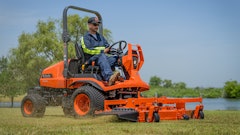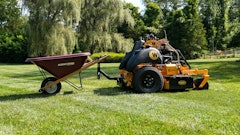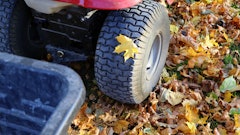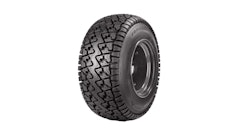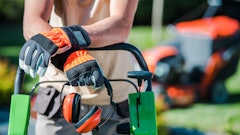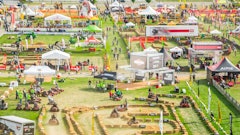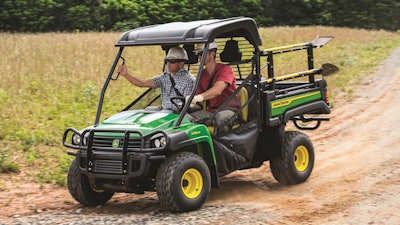
The versality of a utility vehicle (UTV) is its greatest value. It is that element that makes them so popular and continues to fuel demand across the green industry.
“With the housing and home improvement industries booming in many areas of the country, contractors are recognizing the value a UTV can bring to their fleet to perform a wide range of tasks in less time and with reduced effort,” says Maureen McCormack, go-to-market market manager John Deere Gator utility vehicles. “Landscape professionals and other contractors want UTVs that are easier to operate and provide more automotive-like features like instant engagement of 4-wheel drive, enhanced digital displays, and power steering.”
A UTV is a smart, more affordable substitution for larger vehicles that may be used on a jobsite. They are also strong and durable with large payload, towing, and cargo capacities so landscaping crews can easily transport any tools and materials needed for the job, regardless of climate.
The primary audiences for UTVs often vary by vehicle and manufacturer. For example, some UTVs are designed more for recreational use, and some manufacturers cater more to certain customer segments such as landscapers, rural property owners or farmers.
Customers are paying more for added functionality, driving the growth in the full size UTV category.
“The full-size UTV market has been growing at a faster rate than mid-size and compact UTV markets,” says Allen Talley, Cub Cadet utility vehicle business segment director. “People want more power for greater payload and towing capacity, more space to haul equipment and materials, and more room to transport people.”
Due to the growing sales, some manufacturers are struggling to meet the demand for both accessories and vehicles.
“Performance and design are critical for landscapers, so those areas have been the most improved.” says Grant Wilson, director of product management AriensCo. “UTVs offer several benefits on a jobsite to help landscapers work more efficiently and effectively.”
The versality of a UTV adds up to saving precious time and energy. As with many industries, landscapers are facing issues with obtaining and retaining employees.
“Time is money, and UTVs can help save labor hours on transportation around large properties,” Talley says. “Crews can get around properties faster, and instead of lugging heavy materials by hand, they can transport them easily with a UTV. It also saves teams from unnecessary fatigue and makes their daily jobs easier, not to mention putting less wear and tear on the body.”
 Utility vehicles are increasingly popular among a variety of customer segments, with farmers, ranchers and landscapers toward the top of the list.AriensCo.
Utility vehicles are increasingly popular among a variety of customer segments, with farmers, ranchers and landscapers toward the top of the list.AriensCo.
Ideal landscaping applications for a UTV
KIOTI Tractor product development manager Joel Hicks says as demand for UTVs among landscaping and other professionals has grown in recent years, manufacturers have responded with additional feature and accessory options. For many manufacturers, customers can order a UTV that is specifically built to meet their needs.
“The UTV market today has a nearly endless assortment of add-ons that can customize your UTV for exactly the type of work you’ll be performing,” Hicks says. “There’s no denying that landscaping professionals are increasingly viewing UTVs as a powerful, versatile and effective workhorse.”
Whether you’re transporting a crew, hauling gear, clearing debris, or moving landscaping material, UTVs serve as a compact and efficient machine for tackling a wide variety of tasks. With lower overall maintenance and reduced wear and tear due to shorter distances traveled, the UTV has potential to be a greater return on investment than a larger piece of equipment.
“Because UTVs help landscapers and other contractors complete many different types of projects, they’re frequently taking the place of more expensive, less versatile and less reliable pieces of equipment,” Hicks says.
He says a UTV with a large cargo bed, strong weight and substantial towing capacity can greatly improve production.
Another thing to think about is traveling around congested areas of land, such as a bustling commercial site or heavily landscaped residential property.
“Due to their versatility and maneuverability on difficult terrain UTVs help crews travel across large, rough jobsites better than a work truck and with less potential damage to the turf,” Wilson says.
One more example is in irrigation and lighting applications. UTVs can be helpful in traveling around sites to check sprinkler heads for leakages, or lighting fixtures for damaged wiring.
The ability to power a long list of attachments creates an equally long list of productivity-enhancing possibilities.
Tool racks, blades, spreaders, snowplow blades and winches are just a few of the hundreds of attachments available to help landscapers and other contractors get the job done. Other options include the hard-coated windshield available on the Gravely Atlas JSV or light kits offered by many manufacturers including Cub Cadet which allow contractors to work late into the summer hours and get more done during the peak season.
McCormack says John Deere offers multiple UTV accessories that add additional functionality to a UTVs, such as locking toolboxes, cargo box side extensions that will allow operators to haul large, bulky items like landscape timbers and a cargo box lift kit for some models.
“With accessory options to add anything from safety lamps and side mirrors to bed dumping and sun canopy kits, contractors can ensure a UTV meets their power, safety and comfort needs,” Hicks says. “With all these developments, this is an exciting market to be part of in the years ahead.”
Choosing a UTV
There are many brands and models of UTVs today, giving customers a mind-boggling array of options to choose from. Landscaping contractors should first consider the tasks they are hoping to accomplish with the vehicle.
“Landscapers first need to ask themselves how they want to use their UTV because these vehicles are highly customizable,” Talley says.
McCormack adds that UTVs are great for contractors who need to maintain large properties, like office complexes, school campuses, or subdivisions. “With a UTV, you can quickly move around the property, efficiently complete tasks like spreading salt on sidewalks, and move heavy material though spaces where a full-size truck would not fit,” she says.
If a landscaper is looking to tow and haul, important features to consider are payload, towing capacity, cargo bed capacity. engine type (diesel vs. gas) and the type of terrain that will typically be driven on.
 Utility vehicles are becoming more popular with landscapers because of their ability to efficiently travel in a variety of environments, from wide-open spaces to more congested areas with rough terrain.KIOTI Tractor
Utility vehicles are becoming more popular with landscapers because of their ability to efficiently travel in a variety of environments, from wide-open spaces to more congested areas with rough terrain.KIOTI Tractor
“Knowing these three basic things will help a contractor narrow down their choices and prepare them to have a good conversation with their dealer,” McCormack says.
Climate is another consideration. Companies like KIOTI have begun to offer factory-installed and/or field option cabs. In-cab climate control can be an important feature if operating in a very hot environment or if utilizing the UTV in the winter to plow snow.
“Climate-controlled cabs are in demand because contractors want to be comfortable year-round and get more done despite the weather,” McCormack says. “Ultimately, what contractors are looking for in a UTV is versatility. The versatility of a UTV is ultimately its greatest value.”
It’s important for a landscaper to determine what their needs are based on the projects they’ll be doing both today and in the future.
“As always, your dealer is your best resource to provide personalized guidance on selecting the best utility vehicle for your business,” Hicks says. “With the tasks you hope to accomplish in mind, ask your dealer about the ideal UTV for your landscaping applications.”
It is easy for a professional user such as a landscaper to make a bad choice when it comes to a UTV.
Service, maintenance and optimizing performance
When evaluating whether a UTV makes sense for their landscaping operation, one thing a contractor cannot overlook is how they will transport their UTV to a given jobsite. To safely haul a UTV, a 14- to 16-foot trailer and a minimum of two 3,500-pound axles with brakes on both axles is necessary.
Landscape contractors must also think about the ongoing maintenance and overall care of a UTV to get the longest, most productive life possible. “It depends on usage, but generally speaking a UTV won’t need the same type of maintenance as a professional mower,” Talley says. “It’s more in line with the type of service needed on a transport vehicle like a pickup truck. Owners will have to change the oil, maintain the engine, grease the fittings and things like that.”
 A UTV is a smart, more affordable substitution for larger vehicles that may be used on a jobsiteCub Cadet
A UTV is a smart, more affordable substitution for larger vehicles that may be used on a jobsiteCub Cadet
“When in doubt, reach out to your local dealer for assistance,” Hicks says. “Just as with a car, performing routine oil changes, tire checks and other regular maintenance tasks will extend the life of your UTV and ensure it is adding the greatest value to your company.”
According to McCormack, in general, you should change the oil and oil filter every 100 hours, or annually. In addition, she says every 200 hours, or annually, you should change the spark plugs and air filter, check the condition of your drive belt and alternator belt, check brake pad wear, and tighten wheel bolts to the correct torque. Around 800 to 1000 hours, or every 24 months, there are other regular service items like changing the transaxle oil and 4WD front differential oil, replacing the drive belt, flushing the brake fluid, and changing the engine coolant.
“Owners should keep service records for each machine by documenting the date, engine hours, and what service was performed to ensure machines are routinely maintained,” McCormack says.
Before each use Wilson suggests operators check the fluid levels, lubricate the grease fittings, and check the tire pressure.
Since a UTV is typically being asked to do a lot of things on a variety of terrain, proper tire care becomes important.




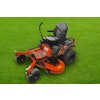
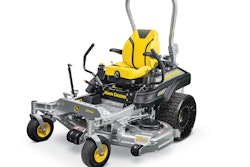








![U8kj71gt 720[1]](https://img.greenindustrypros.com/mindful/acbm/workspaces/default/uploads/2025/10/u8kj71gt-7201.8OyDyc124u.jpg?ar=16%3A9&auto=format%2Ccompress&fit=crop&h=135&q=70&w=240)
